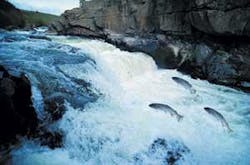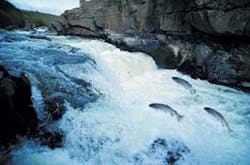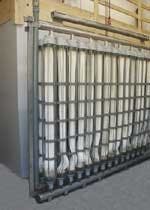Immersed membrane bioreactor system reclaims water for irrigation
By Matt Kuzma
King County officials located in the US state of Washington, are designing a treatment plant in the Sammamish river valley area following a successful pilot plant project that used immersed mem-brane bioreactor (MBR) technology developed by USFilter to provide reclaimed water for local irrigation needs and to address waterway restoration efforts.
The full-scale reclaimed water production facility will be located in this fertile valley where landscaping businesses, sod farms, nurseries, and a golf course rely on the Sammamish River for their irrigation needs. The Sammamish River is a threatened salmon-bearing watercourse where low flow and high water temperature affect local salmon restoration efforts.
The demonstration project, a partnership between Carollo Engineers' Seattle office, King County and USFilter, provides reclaimed water to irrigate several garden plots planted with vegetation by a local nursery.
USFilter's immersed membrane bioreactor system handles liquid/solids separation on a molecular scale. The wastewater reuse process emerged from the combined expertise of two USFilter companies that specialise in advanced wastewater treatment technology. USFilter's Jet Tech Products patented mixing and aeration technology transports air and mixed liquor uniformly and positively around and across microfiltration modules, supplied by USFilter's Memcor Products.
The skid-mounted pilot system includes a cluster assembly with four integral membrane modules. In addition, a skid-mounted filtrate tank stores chemically treated water needed in membrane cleaning. The membrane system is isolated from the main process, so membrane cleaning and service never impair the biological treatment process. The two-phase jet system creates a stable operating environment.
The King County MBR process begins as the influent is pre-treated with a perforated screen and stored in a small equalisation tank. From the equalisation tank, the prescreened wastewater is pumped to the biological process tank. The wastewater undergoes carbonaceous oxidation by injecting and dissolving air into the process fluid through fine bubble diffusers, providing oxygen for biological respiration. This diffused air injected into the bottom of the tanks provides mixing.
Because the separation process in the biological tank relies on submerged membranes rather than clarifiers, sludge settleability is not an issue. This allows the biological process to operate at longer sludge ages (typically 20-50 days) and mixed liquor suspended solids (MLSS) concentrations (typically 10,000 - 15,000 mg/l.). High MLSS concentrations promote numerous process benefits, including stable operation, complete nitrification, and reduced biosolids production in addition to reducing the physical footprint required by the plant.
Submerged membranes in the biological tank consist of polymeric hollow fibres. These hollow fibres are bound together in clusters called modules. By applying a low vacuum to the inside of the hollow fibres, the fully oxidised and nitrified water is pulled through membranes and filtered. Meanwhile, mixed liquor is continuously pumped uniformly with air into each membrane module fibre bundle through the two-phase jet. The resulting flow across membrane fibres (known as cross-flow) continuously scours and cleans the membrane surface.
Author's note
Matt Kuzma is a product manager for USFilter's Jet Tech Products, based in Edwardsville, Kansas, USA.


